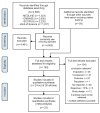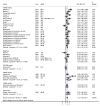Occupational Noise and Hypertension Risk: A Systematic Review and Meta-Analysis
- PMID: 32872306
- PMCID: PMC7504405
- DOI: 10.3390/ijerph17176281
Occupational Noise and Hypertension Risk: A Systematic Review and Meta-Analysis
Abstract
A number of epidemiological studies report an association between occupational noise exposure and arterial hypertension. Existing systematic reviews report conflicting results, so we conducted an updated systematic review with meta-analysis. We registered the review protocol with PROSPERO (registration no.: CRD 42019147923) and searched for observational epidemiological studies in literature databases (Medline, Embase, Scopus, Web of Science). Two independent reviewers screened the titles/abstracts and full texts of the studies. Two reviewers also did the quality assessment and data extraction. Studies without adequate information on recruitment, response, or without a comparison group that was exposed to occupational noise under 80 dB(A) were excluded. The literature search yielded 4583 studies, and 58 studies were found through hand searching. Twenty-four studies were included in the review. The meta-analysis found a pooled effect size (ES) for hypertension (systolic/diastolic blood pressure ≥140/90 mmHg) due to noise exposures ≥80 dB(A) of 1.81 (95% CI 1.51-2.18). There is no substantial risk difference between men and women, but data concerning this question are limited. We found a positive dose-response-relationship: ES = 1.21 (95% CI 0.78-1.87) ≤ 80 dB(A), ES = 1.77 (95% CI 1.36-2.29) >80-≤85 dB(A), and ES = 3.50 (95% CI 1.56-7.86) >85-≤90 dB(A). We found high quality of evidence that occupational noise exposure increases the risk of hypertension.
Keywords: arterial hypertension; blood pressure; dose response relationship; meta-analysis; noise; occupation; systematic review; work.
Conflict of interest statement
The authors declare no conflict of interest. The funding organization had no role in the design of the study; in the collection, analyses, or interpretation of data; in the writing of the manuscript, or in the decision to publish the results.
Figures








Comment in
-
About the relationship between ship noise and the occurrence of arterial hypertension in seafarers.Int Marit Health. 2020;71(4):301. doi: 10.5603/IMH.2020.0053. Int Marit Health. 2020. PMID: 33394499
-
Seafarers' Occupational Noise Exposure and Cardiovascular Risk. Comments to Bolm-Audorff, U.; et al. Occupational Noise and Hypertension Risk: A Systematic Review and Meta-Analysis. Int. J. Environ. Res. Public Health 2020, 17, 6281.Int J Environ Res Public Health. 2021 Jan 28;18(3):1149. doi: 10.3390/ijerph18031149. Int J Environ Res Public Health. 2021. PMID: 33525471 Free PMC article.
-
Reply to Seafarers' Occupational Noise Exposure and Cardiovascular Risk. Comments to Bolm-Audorff, U.; et al. Occupational Noise and Hypertension Risk: A Systematic Review and Meta-Analysis. Int. J. Environ. Res. Public Health 2020, 17, 6281.Int J Environ Res Public Health. 2021 Jan 29;18(3):1188. doi: 10.3390/ijerph18031188. Int J Environ Res Public Health. 2021. PMID: 33572747 Free PMC article.
Similar articles
-
The effect of occupational exposure to noise on ischaemic heart disease, stroke and hypertension: A systematic review and meta-analysis from the WHO/ILO Joint Estimates of the Work-Related Burden of Disease and Injury.Environ Int. 2021 Sep;154:106387. doi: 10.1016/j.envint.2021.106387. Epub 2021 Feb 18. Environ Int. 2021. PMID: 33612311 Free PMC article.
-
WHO/ILO work-related burden of disease and injury: Protocol for systematic reviews of exposure to occupational noise and of the effect of exposure to occupational noise on cardiovascular disease.Environ Int. 2019 Apr;125:567-578. doi: 10.1016/j.envint.2018.09.040. Epub 2019 Jan 23. Environ Int. 2019. PMID: 30683322
-
[Impact of occupational noise in the development of arterial hypertension: A survey carried out in a company of electricity production].Ann Cardiol Angeiol (Paris). 2019 Jun;68(3):168-174. doi: 10.1016/j.ancard.2018.10.008. Epub 2019 Jan 22. Ann Cardiol Angeiol (Paris). 2019. PMID: 30683483 French.
-
Noise exposure in occupational setting associated with elevated blood pressure in China.BMC Public Health. 2017 Jan 23;17(1):107. doi: 10.1186/s12889-017-4050-0. BMC Public Health. 2017. PMID: 28114916 Free PMC article.
-
The prevalence of occupational exposure to noise: A systematic review and meta-analysis from the WHO/ILO Joint Estimates of the Work-related Burden of Disease and Injury.Environ Int. 2021 Sep;154:106380. doi: 10.1016/j.envint.2021.106380. Epub 2021 Apr 17. Environ Int. 2021. PMID: 33875242 Free PMC article.
Cited by
-
Relationship between occupational noise exposure and hypertension: Cross-sectional evidence from real-world.Front Public Health. 2022 Dec 12;10:1037246. doi: 10.3389/fpubh.2022.1037246. eCollection 2022. Front Public Health. 2022. PMID: 36620292 Free PMC article.
-
Evaluation of fetal exposure to environmental noise using a computer-generated model.Nat Commun. 2025 Apr 25;16(1):3916. doi: 10.1038/s41467-025-58983-0. Nat Commun. 2025. PMID: 40280911 Free PMC article.
-
Effects of Noise Exposure and Mental Workload on Physiological Responses during Task Execution.Int J Environ Res Public Health. 2022 Sep 29;19(19):12434. doi: 10.3390/ijerph191912434. Int J Environ Res Public Health. 2022. PMID: 36231736 Free PMC article.
-
Hip osteoarthritis and occupational mechanical exposures: a systematic review and meta-analysis.Scand J Work Environ Health. 2024 May 1;50(4):244-256. doi: 10.5271/sjweh.4152. Epub 2024 Mar 14. Scand J Work Environ Health. 2024. PMID: 38483209 Free PMC article.
-
The Modern Environment: The New Secondary Cause of Hypertension?Medicina (Kaunas). 2023 Nov 29;59(12):2095. doi: 10.3390/medicina59122095. Medicina (Kaunas). 2023. PMID: 38138198 Free PMC article. Review.
References
Publication types
MeSH terms
LinkOut - more resources
Full Text Sources
Medical
Miscellaneous

